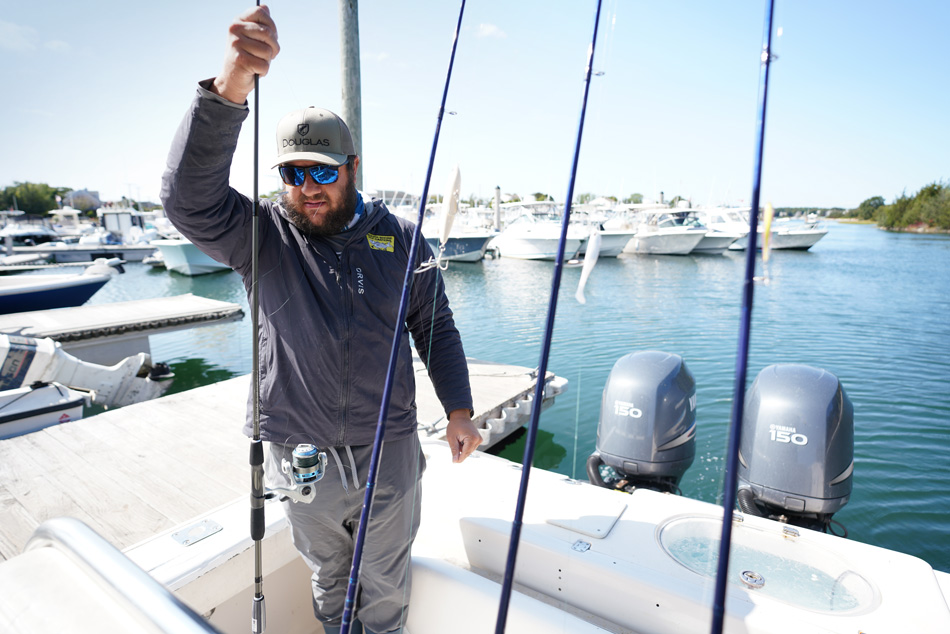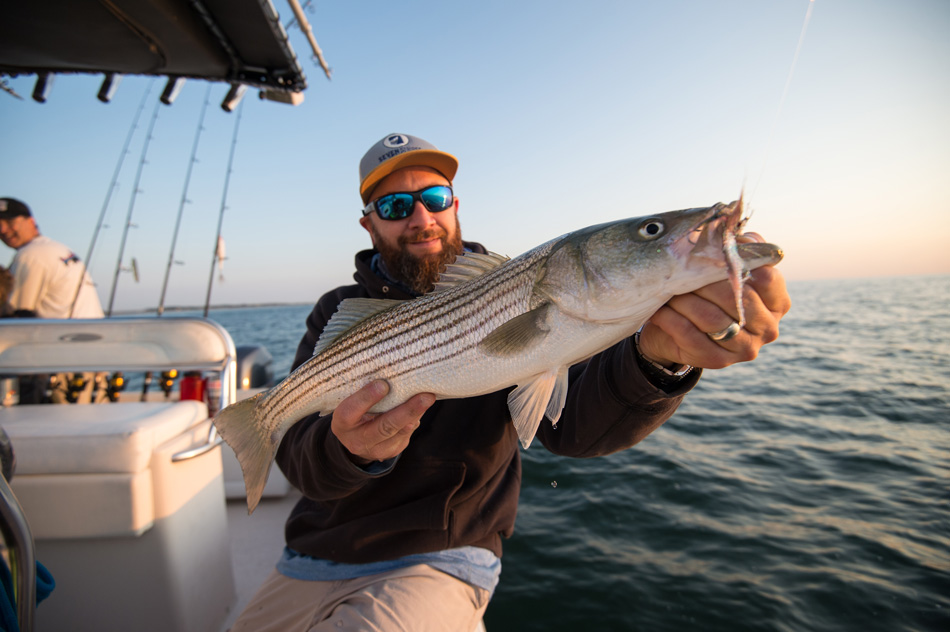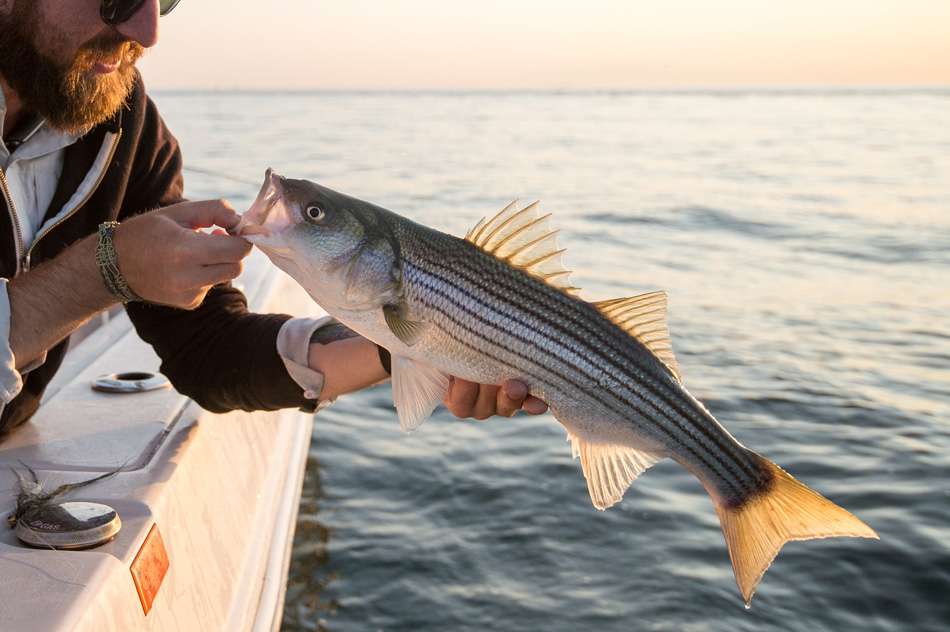Finding success along the striper coast is dependent on figuring out the little things. Every once in a while–maybe once a season–something ‘clicks’ that helps you understand how to catch stripers more consistently. Eventually, these “lightbulb” moments begin to mix, overlap and amalgamate to create some semblance of “Oh yeah, I kind of know what I’m doing.”
How to Catch Stripers
by Billy Mitchell
If you think of fishing as merely catching, this guide isn’t for you. The first step is to change your mindset to realize that figuring it all out is the fun part. It’s an old adage but a good one: “I love it when a plan comes together.” It’s something I originally heard from a friend talking about deer hunting but can be applied to fishing just as easily. Here are five tips to help you find your lightbulb moments when striper fishing.
1) Get out early and stay out late
If you want to catch stripers, you’ll need to lose sleep. The experts recommend eight hours? Come on. There are stripers to catch. You cannot catch fish consistently if you don’t fish while the sun is down. The simplest and most scientific answer I can give you for this is that bass like to feed in low and transitioning light conditions. Also, less boat and fishing traffic means the stripers can get in shallow without being disturbed. Even better, learn to fish at night.

2) Use the right gear
You’re going to have a tough time out there if you’re not using the correct rod, reel, line and lures. Most of the stripers we find in the Cape Cod area are of the “schoolie” variety: 16” – 24”. While the type of forage can vary depending on location and stage of the season, the majority of these fish will be feeding on smaller baits, like peanut bunker, silversides, tinker mackerel, small squid, and crabs.
Thus, you’ll need a rod that can throw the lightweight baits that are required to successfully “match the hatch”, and one that is sensitive enough to feel the subtle tap of a striper slurping a swimbait off the sand.
The Douglas LRS 785F is the perfect rod for light tackle striper fishing. Matched up with a 3000-4000-sized reel, it’s light enough to throw unweighted soft plastics and small plugs like Jumpin’ Minnows or Albie Snax, and has enough backbone to winch in the occasional cow striper. We use 15-pound braid and a 12- to 15-pound fluorocarbon leader depending on water clarity and depth.

3) Study up on striper feeding patterns, figure out ONE spot
Every decision stripers make is based on eating while expending the least amount of energy possible. You’ll find that stripers only feed in certain terrains, structure types and depths during certain tides, wind directions and moon phases. When considering all of these variables, you’ll realize you can pattern the movements and feeding windows of stripers in your home waters.
The easiest way to achieve this is to keep a log. In the winter, study the tide charts around your favorite spots. New Moon tides and big tides around the Full Moons will be periods to target. Remember, big tides mean lots of moving water, which almost always translates to better fishing. Bass are ambush feeders and wait for prey to be swept out into open water to feed.
Figure out the intricacies of your home waters and study them down to a single rock. Pick a spot that you know holds fish and fish it at all times in the moon and tide cycles. Think logically about that spot–about the geographical features and the prevalent bait around it. What draws bass there? Why would you find fish there at certain tide stages and not at others? To get these patterns locked down, you need to think of it as a science experiment, where fishing is your collection of data. No need to wear a lab coat—unless you’re into that sort of thing.

4) Confidence is key. Get REALLY good at ONE tactic
The same way you should learn the ins and outs of a few select spots, you need to focus on one specific technique. Having confidence in a specific location and technique is the number one predictor of success. One tactic that builds confidence is prioritizing times and areas that are likely to feature topwater blitzing.
A big outgoing tide at dawn around inshore tidal flats, especially in May, Early June, September and October, will usually yield spectacular topwater feeds. Look to the birds to find the fish. Heddon Super Spooks, Fin-S soft baits, Hogy Pro Tails, and SP Minnows will usually get the bites if the fish get finicky.
Another tactic to learn is to fish along the inshore tidal flats and the channels that abut them. You’ll typically find stripers throughout entire tides in these locations. At low tide, look to the deeper edges and drag soft plastics with heavier jigheads along the bottom. As the tide floods, look to the shallow sandy areas, bowls and indentations for stripers rooting around on the bottom. Crabs and shrimp are a major part of the stripers diet.

5) Put your time in
You will not catch stripers, or any other type of fish for that matter, if you sleep in. You need to spend time on the water. No matter how prepared you are, some days, it just won’t happen. Remember, this is fishing, not catching. Skunked on a day when all of the conditions seemed to line up perfectly? Get out the next morning. I cannot stress the importance of a short memory.
Here’s a good and very unhealthy way to look at this. When you’re lying in bed after sleeping in, think about how you would feel if you missed the best blitz of the season. The only way to ensure you’ll get into that lifetime fish is being out there. Make your own reports. The more time you spend on the water, the luckier you’ll get.

Article written by Douglas Pro Billy Mitchell of Seven Stripes Fishing Charters in Cape Cod, MA. www.sevenstripesfishing.com
Looking for the Best Striper Rod?
Check out the Douglas LRS 785F spinning rod! Visit a local dealer near you to test it out and make a purchase or shop through an online dealer and get a rod delivered to your home.
